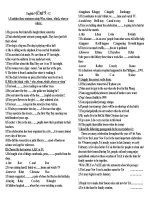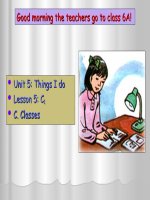Unit 2-English9
Bạn đang xem bản rút gọn của tài liệu. Xem và tải ngay bản đầy đủ của tài liệu tại đây (152.36 KB, 17 trang )
Tan Lam Upper Secondary School English 9
Date of preparation: Teaching date:
Class : 9a, 9b, 9c
UNIT 2: CLOTHING
Period: Getting Started – Listen and Read
I. Objectives: After the lesson, students will be able to know more about ao dai, traditional dress of
Vietnamese women.
1. Grammar: The passive (review).
2. Vocabulary:
Nouns: cotton, design, inspiration, material, novel, poetry, fashion, label,
minority, occasion, poet.
Verbs: slit
II. Preparation: Text book, pictures.
III. Procedures:
Teacher’s activities Students’ activities
WARM UP: (5’)
-Divide class into groups and ask them to look
at the clothes which people are wearing and
take turn to decide where each person comes
from.
Ex. Where does the woman in picture a come
from?
How do you know she comes from Japan?
PRESENTATION: (13’)
Task 1: 5’
- Introduce new words
(n): cotton, design, inspiration, material, novel,
poetry, fashion, label, minority, occasion, poet,
loose pants
(v): slit
Task 2: 4’
-Modal reading.
Task 3: 4’
-Present structures:
+Passive voice:
ex: The ao dai was worn by both man and
woman.
S + be + past participle…..
PRACTICE: (20’)
Task 4: 7’
-Have Ss read the text and complete the
sentences (a/ page 14)
- Group work
-Answer the questions
a. She comes from Japan. She is wearing a
Kimono.
b. She comes from Vietnam. She is wearing
ao dai.
c. He comes from Scotland. He is wearing a
kilt
d. She comes from India. She is wearing a
sari.
e. He comes from the USA. He is wearing
Jeans
f. She comes from Arabia. She is wearing a
veil.
-Copy
- Listen and repeat: Whole class/ individuals.
Listen and copy
-Silent reading
-Pair work
1. poems, novels and songs.
Teacher: Nguyen Quang Hai
Tan Lam Upper Secondary School English 9
Task 5: 7’
-Ask Ss to read the text again and answer the
questions.
Task 6: 6’
-Call some pairs to ask and answer before the
class.
-Correct
PRODUCTION: (5’)
Ask Ss to close the books and retell about what
they have known the ao dai.
HOMEWORK: (2’)
Have Ss learn by heart the new words,
structures and do exercises 5, 6 on pages 16, 17
in workbooks.
2. a long silk tunic with slits up the sides
worn over loose pants
3. to wear modern clothing at work.
4. lines of poetry on it.
5. symbols such as suns, starts, crosses, and
stripes.
-Pair work
-Correct
1. Traditionally, men and women used to
wear the ao dai.
2. Because it is more convenient.
3. They have printed lines of poetry on it or
have added symbols such as suns, starts,
crosses, and stripes to the ao dai.
-Group work/ individual work
- Do at home.
Date of preparation: Teaching date:
Teacher: Nguyen Quang Hai
Tan Lam Upper Secondary School English 9
Class : 9a, 9b, 9c
UNIT 2: CLOTHING
Period: Speak
I. Objectives: After the lesson, students will be able to know some more casual clothes and talk
about what favorite types of clothing they wear on the weekend.
1. Grammar:
- Review of reported speech.
2. Vocabulary:
Nouns: A colorful T-shirt, A sleeveless sweater, A stripe shirt, A plain suit, Faded
jeans, A short-sleeved blouse, Baggy pant, A plaid skirt, Blue shorts
II. Preparation:
Text book, pictures.
III. Procedures:
Teacher’s activities Students’ activities
WARM UP: 5’
-Ask students to describe Vietnamese Ao dai
again.
PRE – SPEAKING: 13’
Task 1: 5’
-Ask students to match names of casual clothes
and the pictures.
Task 2: 5’
- Get feedback to check Vietnamese meanings
- Correct.
Task 3: 3’
-Have students read the name of clothes.
-Have students play the game “Kim’s game” to
check the vocabulary.
WHILE – SPEAKING: 20’
Task 4: 5’
- Ask students to look at the exercise b to read
the questions and answer them.
Ex:
What do you usually wear on the weekend?
…….
Task 5: 5’
- Have students practice in pairs.
Task 6: 2’
- Ask students to add two more questions:
- Whole class
- Group work
-Get feedback
a-A colorful T-shirt
b-A sleeveless sweater
c -A stripe shirt
d-A plain suit
e -Faded jeans
f- A short-sleeved blouse
g -Baggy pants
h -A plaid skirt
i -Blue shorts
-Whole class
-Group work
-Pair work (T-S, S-S)
I usually wear a colorful T-shirt and blue
shorts
- Pair work
- Pair work
1. What type of clothing do you wear on Tet
holiday?
2. What do you wear when you go to the
Teacher: Nguyen Quang Hai
Tan Lam Upper Secondary School English 9
Task 7: 3’
- Call on some pairs to practice in front of the
class.
Task 8: 5’
- Ask students to do the survey with their
partners in groups.
Questions Name
Items
of
clothes
Notes
1. What do you
usually wear on
the weekend?
2. Why do you wear
these clothes?
3. What is your
favorite type of
clothing? Why?
4. Is it comfortable
to wear uniform?
5. What color is it?
6. What type of
clothing do you
usually wear on
Tet holiday?
7. What would you
wear for a party?
POST – SPEAKING: 5’
- Ask students to report the result of their survey.
-Correct
HOMEWORK: 2’
-Have Ss learn by heart the new words,
structures and do exercises in workbooks.
-Ask Ss to write the result of the survey and
prepare: Listen
party?
- Pair work
- Group works
- Individual works.
Ex: + Three people said they liked their
uniform.
+ Lan said that she liked to wear colorful
T- shirts on the weekend.
-Do at home.
Date of preparation: Teaching date:
Class : 9a, 9b, 9c
Teacher: Nguyen Quang Hai
Tan Lam Upper Secondary School English 9
UNIT 2: CLOTHING
Period: Listen
I. Objectives:
After the lesson, students will be able to select the appropriate pictures.
II. Preparation:
Text book, pictures, cassette
III. Procedures:
Teacher’s activities Students’ activities
WARM UP: 5’
Ask Ss to do networks to find words as many
words as possible related to the word “clothing”
Jeans
shorts T- shirt
PRE – LISTENING: 13’
Task 1: 3’
-Ask student to look at the pictures on page 16 and
answer the questions about each of them.
* What are these?
* What is this?
* What color is this?
* What color are these?
Task 2: 2’
-Pre-teach some new words
announcement (n)
missing
entrance (n)
fair (n)
doll (n)
Task 3: 2’
-Model reading
Task 4: 1’
-Introduce the situation of the listening and the
task of the listening exercise
Task 5: 5’
-Have students guess what clothes the girl, Mary,
was wearing when she got lost (type of clothes?
Color? … )
WHILE – LISTENING: 17’
Task 6: 9’
- Play the tape for students twice to check their
answers.
Task 7: 3’
- Ask students to cross-check.
Task 8: 5’
- Ask students to give feedback.
- Correct the answers.
- Group works
Look at the pictures and answer the
questions in groups.
-Take notes.
-Repeat
- Listen
-Group work
- Whole class
- Pair work
- Individual work
a/ She’s wearing blue shorts
b/ She’s wearing a long-sleeved blouse.
Teacher: Nguyen Quang Hai
Clothing
Tan Lam Upper Secondary School English 9
POST – LISTENING: 8’
Task 9: 3’
- Have students report the announcement.
Task 10: 5’
- Ask students to describe what their partners are
wearing today.
Call on some students to report their answer.
HOMEWORK: 2’
-Ask Ss to write a short paragraph about their
favorite casual clothes they like wearing and do
exercises in workbooks and prepare: Reading
c/ She’s wearing brown shoes.
- Individual work
-Pair work
- Individual work
-Do at home.
Date of preparation: Teaching date:
Class : 9a, 9b, 9c
Teacher: Nguyen Quang Hai
Tan Lam Upper Secondary School English 9
UNIT 2: CLOTHING
Period: Read
I. Objectives:
After the lesson, students will be able to know the original history of jeans.
1. Grammar:
Review of past simple.
2. Vocabulary:
(n): material, cotton, style, label, generation, sailor, sale
(v): embroider, wear out
(a): economic
II. Preparation:
Text book, pictures
III. Procedures:
Teacher’s activities Students’ activities
WARM UP: 5’
Brainstorming:
What do you know about jeans?
PRE- READING: 10’
Task 1:1’
-Use the question in warm up to introduce the
lesson.
Task 2: 4’
- Pre- teach new words
.material (n)
.cotton (n)
.style (n)
.embroider (a)
.label (n)
.out of fashion: lổi thời
.generation(n)
.economic situation
.wear out (v)
.sailor (n)
.sale (n)
.stop, begin, start + V-ing
Task 3: 3’
-Model reading
Task 4: 3’
- Have students predict and answer the
questions
a. Where does the word Jeans come from?
b. Where were the 1960s’ fashions?
WHILE – READING: 20’
- Group works
Suggested answer
+ easy to wear
+ convenient
+ fashionable
+ modern
+ … …
- Listen to the teacher
-Copy
- Listen and repeat.
-Answer
a. The word “jeans” comes from a kind of
material that was made in Europe.
b. The 1960s’ fashions were embroidered
jeans, painted jeans and so on.
Teacher: Nguyen Quang Hai









